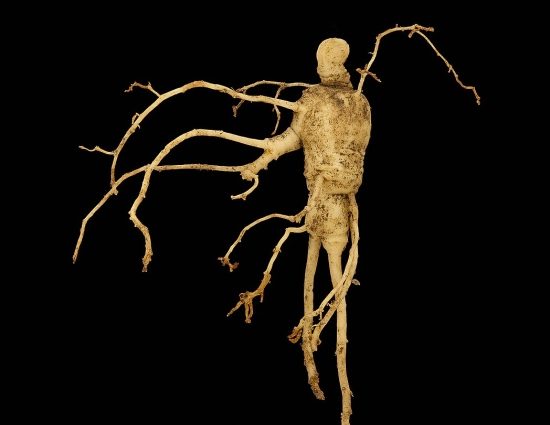**Please consult your physician before consuming ginseng or any other plant.
Wild American ginseng (Panax Quinquefolius) is found in the eastern portion (mostly mountainous region) of the United States and Canada. Other nicknames for the plant are Five Finger (for its five leaflets), Red Berry, Man’s Health, and Man Root.
Wonder of the World
The word ginseng means “wonder of the world.”1)Zak, Victoria. 1999. 20,000 Secrets of Tea. New York: Dell Publishing. And no wonder (No pun intended.). The plant also grows wild in China, Manchuria, and other parts of East Asia. Japan and Korea cultivate it. In Ancient China, the plant was so highly valued that only the emperor could harvest the roots. China has used ginseng in small doses for over 5,000 years to enhance immunity and decrease atrophy. In the Middle East, doctors used ginseng in about the 9th century to help with a variety of illnesses. The plant was used as a popular tonic among wealthy Europeans “after Louis XIV received it as a gift from the King of Siam.”2)Zak, Victoria. 1999. 20,000 Secrets of Tea. New York: Dell Publishing.
About the Man Root
Ginseng is a perennial. Younger plants are small with one leaf and three leaflets that later form two little branches and five leaflets. Older plants (four years and older) grow about two feet tall and have three to five prongs and five leaflets. The fruit is a round, red “drupelike” berry. The small leaves are oblong, egg-shaped, with rough, pointy edges.
The main portion used in the plant is the taproot, which forks off from the main root and is often compared to a man’s body. The root grows at a slow rate and reportedly reaches maturity at around three years. People who “hunt”3)Sengers hunt ginseng in August or September. ginseng are called “Ginsengers,” or “sengers” (pronounced, sangers). A plant with four or more prongs is considered a windfall because the root is likely large. The larger and lighter the root, the better, especially if it’s “plump and unbroken.”4)Zak, Victoria. 1999. 20,000 Secrets of Tea. New York: Dell Publishing. They sell the roots to a distributor for anywhere between $500 to $1000 a pound. That middleman then sells the ginseng to places like China.
The relationship between Appalachian ginseng and the Chinese market extends back centuries.5)Cataneo, Emily. 2020. “The Quest for Appalachia’s Wild Ginseng.” Atlas Obscura. Nov 18.
. . . in the early 1700s, a French priest traveling in China wrote a letter to a fellow clergy member describing ginseng’s popularity in China, where it had been used for centuries as a tonic, stimulant, and fertility booster. By the end of the 1700s, ginseng hunters had swarmed into the Appalachian Mountains, spurred by the demand for the herb in China, where the government had prohibited wild harvesting of the overtaxed crop. 21,000 [sic] metric tons of American ginseng were sent overseas between 1821 and 1983 . . .6)Cataneo, Emily. 2020. “The Quest for Appalachia’s Wild Ginseng.” Atlas Obscura. Nov 18.
Prized Attributes
Ginseng is a prized plant because of its alleged attributes. It is reportedly an excellent stress defense, and has been used to “strengthen organs, calm nerves, stop heart palpitations, brighten vision.”7)Zak, Victoria. 1999. 20,000 Secrets of Tea. New York: Dell Publishing. The root is used to increase “muscle tone, skin tone . . . and to enhance immunity.”8)Zak, Victoria. 1999. 20,000 Secrets of Tea. New York: Dell Publishing. The plant improves energy by stimulating the pituitary and adrenal glands and thereby the nervous system. Its antioxidants “prevent cellular aging,”9)Zak, Victoria. 1999. 20,000 Secrets of Tea. New York: Dell Publishing. and increases the production of both red and white blood cells. Ginseng boosts HDL, or “good,” cholesterol, and helps regulate blood sugar. Ginseng tonic allegedly increases sexual vigor and aids libido by speeding up “hormone secretions in the endocrine system.”10)Zak, Victoria. 1999. 20,000 Secrets of Tea. New York: Dell Publishing. The Cherokee used the plant to treat stomach complaints and women’s ailments, especially after childbirth. Sources agree ginseng mostly benefits elderly persons. Athletes profit as well, because it raises oxygen levels and helps in “quick recovery, with less serum lactate and muscle fatigue.”11)Garrett, J. T. 2003. The Cherokee Herbal. Rochester: Bear & Company. The plant contains the following vitamins and/or minerals: B1, B2, B12, D, Iron, Calcium, Manganese, Magnesium, Zinc.
Use of the plant is not recommended for anyone who has “inflammatory conditions,” 12)Zak, Victoria. 1999. 20,000 Secrets of Tea. New York: Dell Publishing. like bronchitis or high blood pressure. One also shouldn’t use ginseng if taking stimulants.
Take a Chaw or Drink a Tea
A tea made from the plant’s parts is the easiest way to consume ginseng. Koreans allegedly eat the root. Chewing the root helps digestion, prostate, and allegedly “slows cancer growth.”13)Rain, Mary Summer. 1990. Earthway. New York: Pocket Books. The leaves are dried and steeped for tea, and the raw or dried root can be boiled into a tea. Most herb doctors agree that real results take about six months. Some herbalists, however, “don’t recommend taking ginseng for more than a month.”14)Zak, Victoria. 1999. 20,000 Secrets of Tea. New York: Dell Publishing.
Endangered Species
At one time, wild ginseng was everywhere in the Appalachian Mountains. Today, the plant is in danger of extinction due to overharvesting. Typically, persons who harvest ginseng are mountain folk. As a matter of fact, ginseng harvesting goes back generations in many mountain families. Statistically speaking, the majority of sengers are underprivileged.
The government has worked to save the plant through conservation and preservation. Rules have been implemented detailing the time of year as well as the age of the plant to harvest. Mountain people are justifiably distrustful of the government. The reason is a historical one that runs from the Moonshine Wars in the late-1700s to the Coal Creek Wars in the late-1800s to Prohibition in the 1920s to the Tennessee Valley Authority Act in the 1930s, etc. The government has traditionally sided against mountain people and supported coal barons and timber industries and corporations at various intervals throughout history. Consequently, lands were ravaged and stripped and prodded and razed and poisoned. Further, people were displaced and starved and duped and robbed and made poorer generation after generation. Any government entity that comes to the mountains and annexes certain areas of woodlands for conservation or preservation, even for the good of something like ginseng, or tries to stop or change mountain folk from hunting “sang” will be summarily dismissed. Some conservationists and preservationists are told “not to drive a truck with government plates into certain regions” because they’ll “end up with bullet holes” in the vehicle.15)Cataneo, Emily. 2020. “The Quest for Appalachia’s Wild Ginseng.” Atlas Obscura. Nov 18.
Ginseng is now mostly cultivated in Wisconsin. Due to its high demand and popularity, American ginseng is shipped to China and Korea to meet those countries’ demands. Buyers reportedly can tell the difference between wild and cultivated. As a result, the overharvested wild plant has become even more prized and hunted.
One solution is “forest farming.” This method involves intentionally planting ginseng seeds, then harvesting them responsibly. This method is considered better than wrenching every plant in the woods or cultivating them in a place where pesticides are used. Nowadays, many people plant ginseng on their property, unaware they’re actually forest farming.
Reality TV and the Reality of Law
Certain reality shows like Appalachian Outlaws, for example, don’t help matters, though, I must admit, the show is a bit of a guilty pleasure for me. A short rundown of the series: Sengers face all kinds of conflicts and quandaries from terrain, landowners, other sengers, and the law in order to hunt and gather that beautiful cash cow golden root. The episodes are often over-the-top (some say rehearsed) and don’t necessarily represent real ginseng hunting. The executive director of United Plant Savers, Susan Leopold, said the “show has glorified illegal harvest practices and risks having a negative impact on the species’ survival.” Further, “the content of ‘Appalachian Outlaws’ threatens to undermine private landowners’ sustainable production of American ginseng.” Apparently, the show influenced people to dig up ginseng on private properties across Appalachia. These actions further endanger the plant in its semi-natural habitat of forest farming.

The threat of arrest is all-too-real as well. Police in West Virginia arrested eleven people and “seized 190 pounds” of illegally harvested ginseng worth over $180,000. The offenders “violated a ginseng digging law because it was harvested out of season.” Several blamed Appalachian Outlaws for the early harvest wrongdoing. Lieutenant Woodrow Brogan of the West Virginia Division of Natural Resources Law Enforcement said,
We’ve noticed in recent years an increase in people wanting to make a ‘fast buck’ by digging and selling as much ginseng as possible, both in season and out. Much of that increased activity includes unlicensed dealers trading illegal pills for ginseng root.
Conclusion
In case that slipped by the reader: sengers are “trading illegal pills for ginseng root” (emphasis added). That’s how valuable this scraggy little plant is. I’d heard about the dwindling wild ginseng plant decades ago. Even back then, I thought about how nice it would be if we could all just plant it in our gardens and harvest it ourselves. I didn’t know my idea was actually forest farming. I think mountain people have an intuitive sense to protect this land, from flora to fauna. I also think our spirited and rebellious nature sometimes impede these senses. I wonder, though. If we don’t take control of this species ourselves, when will big corporations like Monsanto come and take advantage of our lands, like every other big business has done in Appalachia?
![]()
**Featured image of American ginseng root, 2018 – Wikimedia
The following sources were used in this article. Other sources are linked in the body of the article.
Books:
J. T. Garrett. The Cherokee Herbal. Rochester: Bear & Company, 2003.
Jethro Kloss. Back to Eden. Loma Linda: Back to Eden Books Publishing Co., 1995.
John Lust. The Herb Book. New York: Bantam Books, 1974.
Mary Summer Rain. Earthway. New York: Pocket Books, 1990.
Victoria Zak. 20,000 Secrets of Tea. New York: Dell Publishing, 1999.
Online:
Emily Cataneo. “The Quest for Appalachia’s Wild Ginseng.” Atlas Obscura. Nov 18, 2020.
Real Farmacy. “Dozens Arrested, 190 lbs of Ginseng Seized in Ginseng Raid .” realfarmacy.com. Accessed Apr 2022.
United Plant Savers. “History Channel Criticized for False Portrayal of Ginseng Harvest.” Medicinal Plant Conservation, United Plant Savers. Jan 23, 2014.
References
| ↑1, ↑2, ↑4, ↑7, ↑8, ↑9, ↑10, ↑12, ↑14 | Zak, Victoria. 1999. 20,000 Secrets of Tea. New York: Dell Publishing. |
|---|---|
| ↑3 | Sengers hunt ginseng in August or September. |
| ↑5, ↑6, ↑15 | Cataneo, Emily. 2020. “The Quest for Appalachia’s Wild Ginseng.” Atlas Obscura. Nov 18. |
| ↑11 | Garrett, J. T. 2003. The Cherokee Herbal. Rochester: Bear & Company. |
| ↑13 | Rain, Mary Summer. 1990. Earthway. New York: Pocket Books. |









